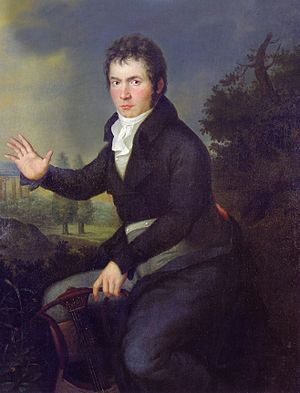Violin Concerto (Beethoven) facts for kids
The Violin Concerto in D major, Op. 61 is a famous piece of music. It was written for a solo violin and a full orchestra. The famous composer Ludwig van Beethoven created it in 1806. He wrote it for a talented violinist named Franz Clement.
Contents
Beethoven's Amazing Violin Concerto
A concerto is a special type of musical piece. It features one main instrument, called the soloist. This soloist plays along with a larger group of instruments, the orchestra. In this concerto, the violin is the star! The "Op. 61" part means it was the 61st work Beethoven published.
The Story Behind the Music
Ludwig van Beethoven was a very important German composer. He lived from 1770 to 1827. He wrote many famous pieces, including symphonies and piano sonatas.
Beethoven wrote this violin concerto in 1806. He created it for Franz Clement. Clement was a great violinist and conductor. He worked with the orchestra at the Theatre an der Wien in Vienna, Austria.
When the concerto was first played, people didn't love it right away. It took some time for it to become popular. Many years later, in 1844, another famous composer, Felix Mendelssohn, helped it become well-known. He conducted it in London, and then everyone realized how special it was!
Listening to the Music
This concerto is known for its beautiful melodies and powerful sounds. It has three main parts, called movements. Each movement has its own mood and style.
First Movement: A Grand Beginning
The concerto starts in a very unique way. You hear a few soft taps on the timpani. Timpani are large drums, sometimes called "kettledrums." Because of this special start, some people even called this piece the "Kettledrum Concerto." This first movement is quite long, lasting about 25 minutes. It has a grand and dramatic feeling.
Second Movement: Calm and Peaceful
After the exciting first movement, the second movement is very different. It is much calmer and more peaceful. It feels serene and quiet. There are no big dramatic moments here. It's a chance to relax and enjoy the beautiful melodies.
Third Movement: Lively and Fun
The last movement is full of energy and happiness. It's very lively and cheerful. This part of the concerto is also very challenging for the solo violinist. It requires a lot of skill and speed to play all the fast and tricky notes. It's a fun and exciting way to end the piece!
See also
 In Spanish: Concierto para violín (Beethoven) para niños
In Spanish: Concierto para violín (Beethoven) para niños


